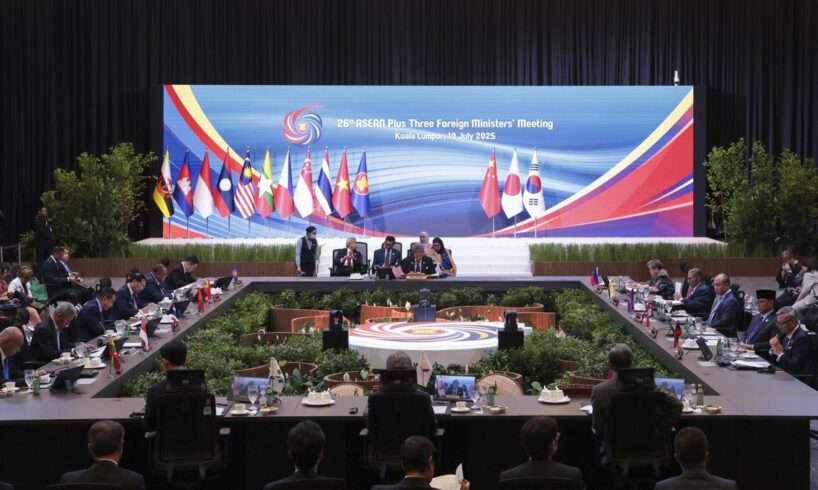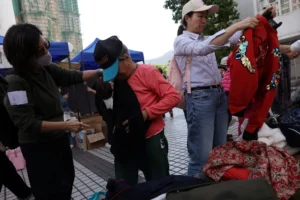
KUALA LUMPUR – The second day of the Asean Foreign Ministers’ Meeting and Related Meetings on July 10 was packed with high-level engagements, including some 10 separate meetings between the grouping and key partners.
But despite the intense diplomatic schedule, one topic continued to dominate conversations in and outside the halls of the Kuala Lumpur Convention Centre: tariffs.
In the media centre, journalists were glued to laptops and phones, tracking updates on how their countries were handling letters from Washington outlining revised United States tariff rates.
Eight out of 10 Asean countries have received formal notifications over the past two days, with Singapore and Vietnam’s expected to follow soon.
Diplomats and ministers, too, appeared preoccupied, with the mood reflected in several speeches delivered during the day.
US Secretary of State Marco Rubio, who met regional ministers at the Asean Post-Ministerial Conference on July 10, defended the tariff hikes as necessary for fairer trade.
Speaking to reporters after the meeting, he said US President Donald Trump believes the state of global trade is unfair to America, and that for far too long, imbalances have been allowed to develop.
“So this is a globalised effort to reset US trade in a way that’s beneficial to the United States. And not just in dollars and cents, but also in our own domestic industrial capacity. So this has been made clear to countries around the world,” he said.
For Asean, the US’ trade policy upheaval has been a reminder of how external shocks can hijack even the most meticulously planned diplomatic calendar.
President Trump on July 8
announced hefty levies
of between 25 per cent and 40 per cent on six Asean nations. Singapore has not received any formal notification from the White House.
Ms Joanne Lin from the ISEAS – Yusof Ishak Institute pointed out how the timing of the US announcements, just before and during the meetings, only heightened the buzz surrounding the issue.
Diplomats noted that while discussions on digital trade, energy cooperation, and Timor-Leste’s upcoming accession to Asean were ongoing, tariffs were never far from people’s minds.
Observers whom I was in touch with throughout the day commented about how the issue has dominated regional discourse, pushing aside other priorities Asean had hoped to advance.
“Tariffs have dominated the regional discussion, which is to be expected with Trump’s insistence to reset world trade in favour of the US,” said Dr Mustafa Izzuddin, a senior international affairs analyst at business consultancy Solaris Strategies Singapore.
“Attention is being diverted from other issues, and it seems like the Asean chair feels that the tariff issue is the most pressing right now, compared to the rest.”
Prime Minister Anwar Ibrahim of Malaysia, which chairs Asean, on July 9
urged the group to “act with purpose”
and enhance trade among one another in the face of global uncertainty. He zeroed in on trade, and described tariffs, export restrictions and investment barriers as “the sharpened instruments of geopolitical rivalry”.
Datuk Seri Anwar said: “As we navigate external pressures, we need to fortify our internal foundations. Trade more among ourselves, invest more in one another, and advance integration across sectors with resolve.”
While Asean has not adopted a common stance, the uneven impact of the new tariffs and the pursuit of individual deals by countries such as Vietnam have tested the grouping’s ability to maintain a united position.
But rather than derailing cooperation, this has sharpened the urgency to deepen regional economic integration.
Compared with the full implementation of
Asean’s Five-Point Consensus on Myanmar
– long stalled by internal divisions and the bloc’s principle of non-interference – deeper trade cooperation may be a more achievable common goal.
The collective, though varied, pain felt across Asia may even provide renewed impetus for China and Asean to push the
Code of Conduct (COC) negotiations
past the finish line. The COC is meant to manage tensions in the South China Sea, where there are overlapping maritime claims.
Chinese Foreign Minister Wang Yi, at a meeting with Asean leaders,
called on the region to resist protectionism
and instead champion openness and cooperation. “Together with the Asean countries, we will promote the Asian values of peace, cooperation, openness and inclusiveness,” he said.
Progress on the COC has been hampered by a lack of consensus between China and Asean, as well as differing threat perceptions and national interests among the group – and this was one of the priorities revisited at the Asean meet.
In a meeting with China on July 10, Malaysia’s Foreign Minister Mohamad Hasan called for “wisdom and prudence” to uphold peace and stability in the South China Sea.
He warned that any disruption to the vital waterway could have far-reaching implications for global trade, saying: “We must therefore ensure that geopolitical tensions do not escalate or threaten to undermine security and global trade in the South China Sea.”
As for the headline economic challenge, Asean leaders look set to make the grouping’s strongest responses yet to the growing pressure since the Trump administration first floated the tariff policy earlier in 2025.
A draft of the joint communique seen by The Straits Times that typically wraps up the full series of foreign ministers’ engagements indicates that the Asean leaders are set to express concern over the “unilateral actions relating to tariffs” that are “counterproductive” and risk “exacerbating global economic fragmentation”.
Top leaders have already signalled the direction ahead: Malaysia’s Mr Anwar has warned that the trade conflict is “not a passing storm” and urged the bloc to strengthen ties within the grouping.
Singapore Prime Minister Lawrence Wong has also
issued a call for “bolder reforms” in the group
, including deeper integration, streamlined trade and investment frameworks, and digital connectivity, to bolster Asean’s relevance and resilience.
Whatever language makes it into the final carefully calibrated communique, the bigger test lies ahead. Asean has shown it can speak with one voice; the challenge now is how to translate that into tangible, collective action. This means facilitating cross-border business operations within South-east Asia, reducing trade and investment barriers, and enhancing regulatory coordination.
Steps are already under way to achieve this.
For instance, in the realm of digital payments, several Asean countries have begun linking their national payment systems, allowing users to make cross-border transactions using QR codes or mobile apps, making trade and travel more seamless across the region.
As economic pressures intensify and partners look for direction, the world will be watching not just what the region says, but also how it moves.





